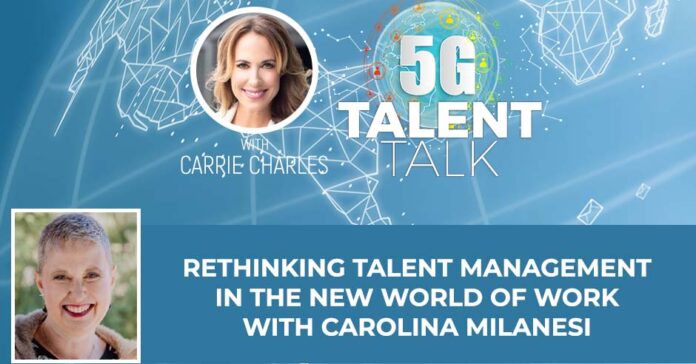As workforce trends shift, companies have begun rethinking talent management strategy. With the youngest generations entering the workforce, companies are tasked with finding a way to keep them engaged and employed. In this episode, The Heart of Tech founder Carolina Milanesi discusses workforce trends since the start of the pandemic through the lens of her experience as a consumer technology analyst. The new generations are more purpose-driven employees, giving companies opportunity and motivation to prioritize supporting diversity, inclusion, social justice and equity as a pillar of their organizations.
Tune in for in-depth insight on talent management as Carolina and Carrie discuss prioritizing people, increasing employee satisfaction and the critical leadership skill of having empathy.
—
Watch the episode here
Listen to the podcast here
Rethinking Talent Management in the New World of Work with Carolina Milanesi
I am so happy that you have joined me. I have with me a special guest. We are going to talk about this new world of work. Things have changed. There are a lot of leaders that are out there wondering, “How do I operate in this new talent landscape with retention and engagement?” We have so many questions now. I have with me Carolina Milanesi. She’s the President and Principal Analyst of Creative Strategies and the Founder of The Heart of Tech. Carolina, thank you so much for joining me.
Thank you so much for having me. I always enjoy our conversations about talent. It’s never been more critical today to talk about talent.
Carolina, you have an interesting past in how you got to where you are now. I cannot wait to know more about The Heart of Tech. Can you tell me more about what led you here now?
By trade, I’m an industry analyst. That means that I provide advice to technology companies on their products, go-to market, and competitive landscape. I’ve been doing this for a long time. I was VP at Gartner for fourteen years, then I left and went to lead the US business for Kantar. I realized through the twenty-plus years of my career as a woman in tech, even if dotted line, that there’s still a lot of work that needs to be done when it comes to diversity and inclusion and leading more of a heart of tech.
In 2019, that’s what I did. I created a company that focuses on ESG and CSR, looking at the impact of technology on society, diversity and inclusion, sustainability, and governance. Talking about ethos, values, and a need to start thinking about technology with yes, they can entertain and be cool. It also can change lives, so I’m putting more of a focus on that.
Tell me more about The Heart of Tech. Who are your clients and customers? How do you serve them?
I deal with large technology companies, and I work with them on their ESG strategy, so Environmental, Social, and Responsibility across the board. We talk about, both internally and externally, how do you become a more diverse and inclusive company? How do you work with your partners, ecosystem, and customers? What is your strategy for sustainability, both from a product perspective and services perspective? Do you enable your customers to be more sustainable?
People want more flexibility in work. It has now become a top priority for employees.
Trying to go from what I felt a few years ago was a lot of marketing and little substance. By all means, I don’t mean because of me, but in general, I am delighted that the industry is putting money to change the way that they’re thinking about their products and they have changed their priorities. This is critical, not just for their business, but it’s critical to attract talent nowadays. Younger generations are driven by purpose. That’s what I do.
How has the workforce changed in the last few years from your view?
How has it not changed? Clearly, we have become more accustomed to what you and I are doing now, which is connecting through a camera and spending time trying to be productive or connecting on a more social level. The biggest change that I’ve seen that is applying to the talent is being a reassessment of what matters to them.
I know that there are a lot of leaders out there that brush this off with, “Everybody has a mortgage to pay. Everybody has to think about sending the kids to college.” I’m sure that at the end of the day, it’s all about money. It isn’t anymore. Of course, people need to pay bills and they want to be paid fairly. This is becoming more of a topic.
I was saying that talking about money has become way more natural to the younger generation than to my generation. It was taboo to talk about how much you were getting paid. Now, people do that. Money aside, there’s more of a focus and a need to balance their life. I always say that finding balance is utopia. You end up driving yourself crazy. What people want is a blended life, the ability to one day be 80% work and 20% family. The average is around 80% family and 20% work. You are still getting work done, but you do it at your pace and with your criteria of what matters in mind.
That blended life has pushed people to want more flexibility in work. Sometimes that means hybrid work, but it also means flexibility from a toolset perspective that you’re using, from a device perspective, technology flexibility, as well as, “Where do I work? How many hours do I work? Do I work a four-day week and not a five-day week?” Those things have now become a top priority for employees.

What do leaders need to do differently? How do they need to think differently so they can be successful with this new shift in the workforce?
The first thing is to think about the changing equilibrium between managers and leaders and talent overall. We used to think that all the power was in the managers and leaders, but not anymore. Things have changed. If you think about the big impact of social media and how you often see disgruntled employees going out and voicing their dissatisfaction with what an organization is doing, that does more damage to you than you may realize. It’s not just about your talent and retaining and acquiring talent, but it’s also about your customers questioning your values and your ethics.
That’s one thing, that power shift that we’ve seen. The other one is that we used to poll our employees once a year. You go out and do a big survey asking all sorts of questions like, “How happy are you?” That’s no longer the case. You need to keep in touch with your employees more than one way. Surveys are useful. There are a lot of different solutions that help you every day. It’s just a question of, “Is it a money or a frowny?” Feel the pulse of where everybody is at.
We are in the era of 5G and data. You have an abundance of data that you can look at, and you can then extrapolate your strategy as to how you can do things differently and how you can cater to your employee better. It’s been quite fascinating to me for many years now how organizations, especially B2C organizations that are so focused on customers, don’t think the employees are customers. If you’re thinking about the role of IT, that’s what the IT manager has to do. It has to serve its customers, which are the employees, and yet we don’t think about people like that.
There are so much golden nuggets in everything that you said. You mentioned something about the new generations in the workforce. How do we keep these younger people engaged and keep them employed with us?
That has changed as well during the pandemic. If I look at tech in Silicon Valley, a lot of the benefits that younger employees were getting on campus because we didn’t have it at home were about the cafeteria, free food, all the glitz and blitz that you can have. Having been away for two-plus years from campus, they found different ways to cater to that.
You need to keep in touch with your employees in more ways than one.
Looking at the benefits and reassessing that, maybe it’s not about the gym on campus, maybe it’s to pay a subscription for them to something that they can do at home or somewhere else, reassessing what was valuable to your workforce before and after. Younger generations are more purpose-driven employees. They want to know that they’re making a difference. They want to know what the company stands for and what they personally stand for is aligned with what the company stands for. They want an organization that is supporting diversity, inclusion, social justice, and equity, both from their products and from an employee standpoint.
There’s a desire to be more in touch with management, have more regular conversations and touchpoints, and feel that they can contribute to that conversation and they’re part of the decision process, which leads to wanting more transparency and better communication. My generation was used to getting told what to do, and you just do it. Honestly, that’s how it was. You don’t question it. You might secretly hope that, especially when you’re in a large organization, things change quickly. It’s like, “I’m not even going to worry about it because, in six months, it will be different.” You just go with the flow.
Things change so rapidly now, especially in technology. With diversity and inclusion, where are we now? Where are companies falling short today?
At least diversity and inclusion are on everybody’s agenda. Everybody is coming at it from a different point. There are companies getting started to talk about it and taking steps. There are companies that have been on this path for a few years. Sadly, if you’re looking at the numbers, especially with a large organization producing a diversity and inclusion report every year, the numbers are moving slowly.
I always say to my customers, “If it was an easy problem to solve, we would have solved it by now because this has been going on for a long time.” The issue is not just one thing. You can’t turn a switch. Flip a switch and things are going to change. You need to think about the pipeline, but the pipeline is not an excuse to say that you cannot be diverse today. You’re not like, “I have to wait for the generation of teens that is in school now to be able to be diverse.”
Certainly, fostering a love for technology, math, engineering, and everything that comes with it at a younger age is going to get people interested. More importantly, it’s when they get to college level that what you do today in your organization is going to get people to decide where they’re going to go from a career perspective. I cannot be what I cannot see. That is simple. If I don’t see women in leadership roles, if I don’t see people of color in leadership roles, I’m not going to go in that organization and think that in my career, I will be the first one. Sometimes you are, but it’s less enticing than not going into an organization that is showcasing the talent and the diversity that they have at the C-level.

Acquiring talent is the diversity from a hiring perspective but then inclusion has to be core because if you hire and then you don’t include, most people want to stay. The key to it is making your organization more inclusive, having more voices and more people at the table. Making sure that, not from a performative perspective, but because you understand that having more diversity of thoughts versus experience will get you to serve your customers better and get your business to be more successful.
I always think about and say to customers, “You need to think about diversity and inclusion the same way you think about profitability and your books. It’s a non-ongoing work that will reflect.” It’s not like you have a chief diversity officer and a chief financial officer. It’s not even a chief financial officer when you’re doing great, and you’re in the green, goes off and goes on holiday. Keep on looking at your finances and keep on working. It has to be the same thing. It’s not a side project. It’s a pillar of your organization.
You can’t be what you can’t see. I love that. I’m going to steal that one but I’ll give you credit. I’m a business leader and I have a company. For the next few years, what does this new workplace look like? What do I need to know now in order to build the right workplace so I can attract and retain the highest and the best talent?
The first thing is you’re going to face a diverse workforce. We have five different generations in the workforce, which means that you cannot think that you cater to all of them in the same way. One-size-fits-all is not the approach you need to take because people have different needs, as we’ve seen every day with this conversation about hybrid work. Some people want to come back, and some people want to stay home. Look at why they want to do certain things. One thing that is critical is people are worried that staying home, which is where they want to stay. They want to stay remote, which will not give them the same opportunity as going into the office.
We’ve been trained like, “My manager has to see me at 7:00 AM and 9:00 PM in the office even if the manager leaves at 5:00.” There’s always that fear that if people don’t see you working, you’re not working. We need to change that from a cultural perspective. Have your managers work remotely. Make sure that the way that we start both hiring and then rewarding employees change. Look at what jobs require a college education, and which don’t. Look at how many years of experience. I’ve always laughed at, “I could never go back to a job now,” because they asked you to be a graduate and have five years of experience. “When am I going to do that?”
Be sure that when you’re looking to fill your roles and write your job specification, you’re inclusive. You’re looking at the needs from an education perspective. More and more, the skillsets that people have rather than the knowledge are going to be important. A lot of the things that we’ve been doing now are going to be fulfilled by technologies like AI. The skillset that you’re looking for changes constantly. Give the opportunity to the talent that you have as part of your inclusion strategy, the opportunity to upskill or reskill. Look at their strength as an individual and see if there’s maybe a role that suits them better and will get them more engaged.
You need to think about the pipeline, but the pipeline is not an excuse to say that you cannot be diverse today.
Don’t have somebody come in and for 5 or 6 years, they’re there doing the same thing when you can see that the passion is not quite what it used to be at the beginning. Be in tune with reskilling, upskilling, and inclusion from a cultural perspective. Understand more what drives people. I know it sounds a little touchy-feely, but it’s not.
The one thing that is key and a superpower that managers and leaders will have to earn, learn and get adjusted to is empathy. That is the superpower that the leaders will have from now on. That is something that we didn’t use to value. You were taught that as a leader, you weren’t supposed to listen. You talk. You’re the one who is supposed to tell people what to do. That’s no longer because empathy would be a critical skill from a leadership perspective.
In your work with companies, what are some of the common mistakes that you see? Maybe you can throw in a couple of solutions there as well.
There are companies that think that they can hire their way out of a lack of diversity and that’s not how you’re going to do it. If you hire and you don’t, then create a culture of inclusion, you’re not going to keep those people. That’s one thing. The other one is the performative part of the role that they have. They might have good benefits or doing events or they have people coming in talking about sustainability, inclusion, or whatever the hot topic of the moment is. They don’t follow up with the structure of the company and what is needed to make a clear difference to people.
The last one that is absolutely critical is middle management. Middle management is often forgotten. We’ve seen in services that we’ve done that there was a study that Microsoft published that also talked about how middle management right now especially is under so much pressure. They hear more clearly what the talent wants, but they are not empowered by leaders to deliver on that.
Never forget the power of that middle management because that’s where inclusion and retention start. We’ve empowered employees during the pandemic to be way more independent than we ever let them be before because they weren’t in the office. They have to make decisions about their setup, their technology, and everything else. Continue to trust that they can do that, and they can be empowered to make decisions that benefit their team. That will help drive a better culture.

Companies need to focus. I’m passionate about this topic, too. It’s focusing on management because those are the people with ears to the ground. They know what’s going on. They hear it. They make the most difference and have the most impact because they’re working closely with these people every day. People don’t leave jobs, they leave managers.
When companies are looking at, “What kind of leadership development training coaching do I need?” They should focus on that middle layer of management and, most importantly, new managers and new leaders. For anybody placed in that position, they’ve got to have training and development because that’s who’s working closely with the people who either are going to stay or leave. Let’s get our crystal balls out and talk about the future. What trends are you seeing in your world? What are some challenges or roadblocks that you see ahead? I want to access your inner futurist right now.
There’s so much going on right now with technology, to be honest with you. One is the fact that our workflows are going to be more digital. Linking to a hybrid work, as we figure out this world where it doesn’t matter where we work, how we work, and that’s how I talk about hybrid work, it’s not where but how, you need to realize that everything that we do is now linked to the digital world. We haven’t quite figured out all the etiquettes around that. How do we do the pre and post-meeting? How do we share the information?
The more that we think about digital workflows, the more we realize how much we are dependent on technology. There are technologies that are now, as much as I hate this term, infused with AI. They do things for us. I don’t have to worry about my email that surfaces some things like, “You said you were going to reply to Carrie two days ago, but you haven’t.” It’s a little nudge. Before, it was a PA that would tell me that, right now, it’s a machine.
In the balance or relationship between technology and humans, I know that there’s a lot of anxiety around AI and automation as well from people, depending on which line of business you are. The more you’re a knowledge worker, the less you’re worried about where AI and automation, in particular, are going to come in. If you work on a factory floor, there’s a big concern there.
For me, it’s understanding and, from a leadership perspective, explaining what the opportunities are. What is automation going to do for the company, and making sure that the people that used to do a task that’s now performed by a computer or a robot will have the opportunity to get reskilled, retrained and repurposed within the organization? That’s why I was talking about rescaling and upskilling as a way to retain talent and also discover new abilities that the talent already has.
Empathy is a critical skill from a leadership perspective.
Also, not thinking that people are disposable. Right now, many people think just because of how hard it is to get talent. Don’t say, “I’m going to cycle people through.” As much as the skills and the knowledge are important, the knowledge of your business is important. That’s one of the things that I always talk about for the older generation, which empowers off within a company. I might not know all the digital stuff that you guys do, young Gen Z-ers and Millennials, but I know the company. Make sure that you enable those connections to where the people that know the business and the company work for hand-in-hand and side-by-side with the people who are more digital native and understand technology.
Lastly, with everything that we have learned during the pandemic, my big desire is not to waste it. We’ve had so much innovation over the past few years from a technology perspective. Stay on that path to make your business better and make your employees more engaged and happier. If you do that, productivity and success will come. Don’t focus on, “Let’s make them more productive.” Focus on, “Let’s make them happier and more engaged because if they are happier and more engaged, they will be more productive and your company will be more successful.”
Carolina, you are full of knowledge and information. I would love to be one of your clients. We’re not big enough yet. I want to thank you so much for coming on the show and for sharing everything that’s going to help the audience, leaders, and companies right now. This is much needed information. Thank you so much for coming on. Please tell me, how can people reach you? I’m sure there are a lot of people in the audience who are saying, “I want to get a hold of her. I want to connect with her.” How do we do that?
First of all, thank you so much for having me. I know how passionate you are about talent and the future of talent, so it was a delight when you asked me to come on. As far as where people can find me, more consistently, they can find me on Twitter, @Caro_Milanesi. I am getting better at LinkedIn. I am on Instagram under the same name. On LinkedIn, Carolina Milanesi. I have a weekly column on Forbes. My websites are CreativeStrategies.com and TheHeartOfTech.com.
Thank you, Carolina. I hope that we can follow up with another episode a little bit in the future. I truly have enjoyed this conversation.
Thank you so much for having me.
Important Links
- Creative Strategies
- The Heart of Tech
- @Caro_Milanesi – Twitter
- Instagram – Carolina Milanesi
- Carolina Milanesi – LinkedIn
- Forbes – Carolina Milanesi
About Carolina Milanesi
 Carolina has over 15 years of experience in the consumer technology industry, most recently as President and Principal Analyst at Creative Strategies. Carolina focuses on a broad range of consumer technologies and services. Her passion for user engagement and user experience drove her to increasingly spend time analyzing the future of work.
Carolina has over 15 years of experience in the consumer technology industry, most recently as President and Principal Analyst at Creative Strategies. Carolina focuses on a broad range of consumer technologies and services. Her passion for user engagement and user experience drove her to increasingly spend time analyzing the future of work.
In 2019, Carolina founded The Heart of Tech. Her newest endeavor aims to help technology providers with their corporate social responsibility efforts especially on DEI.
Between 2013 and 2016, Carolina was Chief of Research at Kantar Worldpanel ComTech. Prior to her ComTech role, Carolina spent 14 years at Gartner, most recently as their Consumer Devices Research VP.
Carolina is a regular contributor to Forbes, Fast Company and Italian daily La Stampa.
Love the show? Subscribe, rate, review, and share!
Join the 5G Talent Talk Community today:

